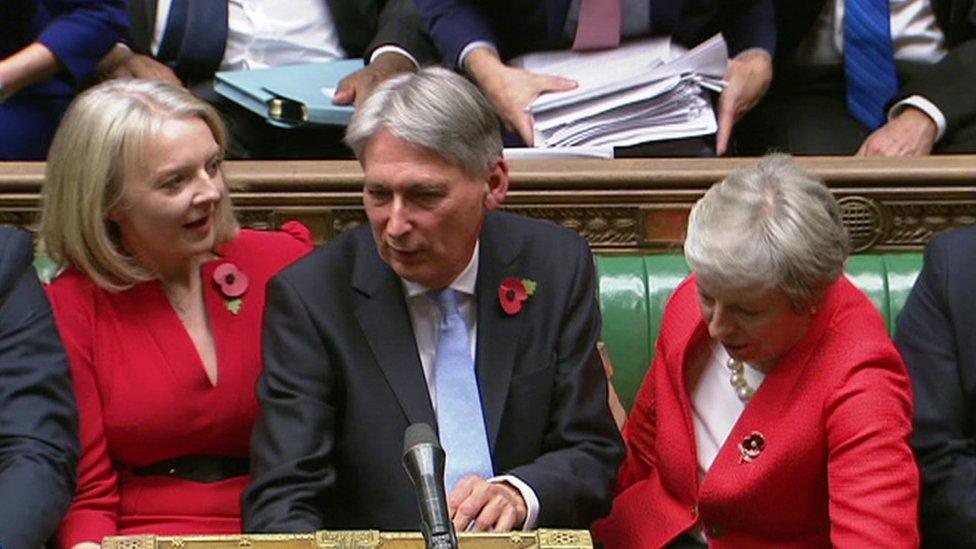The Budget's big picture emerges
- Published

The dust hasn't quite settled but we're a good few hours on from when the chancellor squeezed himself back down onto the government front bench, in between a pleased-looking prime minister and his ever-enthusiastic colleague Liz Truss, his number two at the Treasury.
A few hours when certainly not everything has become clear, no doubt a few nasties will crawl out from under the rocks through the course of tomorrow according to Budget tradition, but the broad shape of the Budget and its impact are becoming clear.
First off, it is, on the face of it, a big change in direction - a Tory chancellor talking about turning on the spending taps again, rather than how to scrimp and save.
You'll see headlines about the 'biggest giveaway' in a generation. That's accurate in terms of the overall numbers, and the sense that government departments on average from next year will see spending go up not down.
And it's different certainly to see a Conservative resident of No 11 putting that ahead of finishing off the attempts to clear the deficit. This chancellor is in fact seemingly content to let the deficit float up. That would have, until relatively recently, been considered heresy round his way.
Politically, it's a big change of priority and has allowed the government to change its rhetoric substantially.
But if you look carefully, a huge amount of that money will be gobbled up quickly by the health service. After that, by some calculations, there simply won't be much to go around - and some departments might even still face cuts.
This sets the stage for a brutal spending review next year with Cabinet ministers, apart from the health secretary Matt Hancock, still vying to be the ones who can get their hands on extra money.
For those who fail, and more importantly those who rely on the services delivered by their departments and local councils, the spending squeeze won't have come to an end at all.
For spending hawks like the chancellor however, together with his next door neighbour in Number 10, today is perhaps about grappling with a political reality - that the public appetite for austerity is much diminished, if not completely exhausted.
But this is a return to spending, not an enormous splurge. Ministers will still have to contend with tight limits on spending and the economy is still predicted to grow at a pretty sluggish rate.
Offering tax cuts more quickly by raising income tax thresholds immediately after Brexit will put money into millions of voters' pockets, perhaps just at the right time (remember though those tax cuts put a lot more in the wallets of the wealthy than basic rate payer).
And as a senior Cabinet minister claimed this afternoon, the Budget creates a new, "useful" dividing line (yes one of those old Westminster chestnuts) with the Labour Party in the months and years to come.
Instead of the basic - Tory cuts versus Labour spending - after today, both parties would spend more on public services but the Tories will do it without raising taxes.
That, they hope, could become a persuasive Tory pitch to most voters in the middle, who don't want to hand over a lot more of their incomes to the government, but don't want to see teachers disappearing at their school, potholes in their roads, or wait for hours at A&E.
That hope could be just that, a hope. The forecasts on which today's Budget is based could turn out to be as wrong as those that have gone before. Eight years of a squeeze on spending, particularly in local government, can't be unpicked overnight.
The questions about Brexit persist, not just over the economy but over the chancellor and prime minister's futures too.
If the next few months unfurl as they hope, and they are still around, it is now clear where they would like to put down their anchor.
But it's up to the rest of the EU, the wider fortunes of the economy, and ultimately the public, to determine if they can.
- Published29 October 2018
